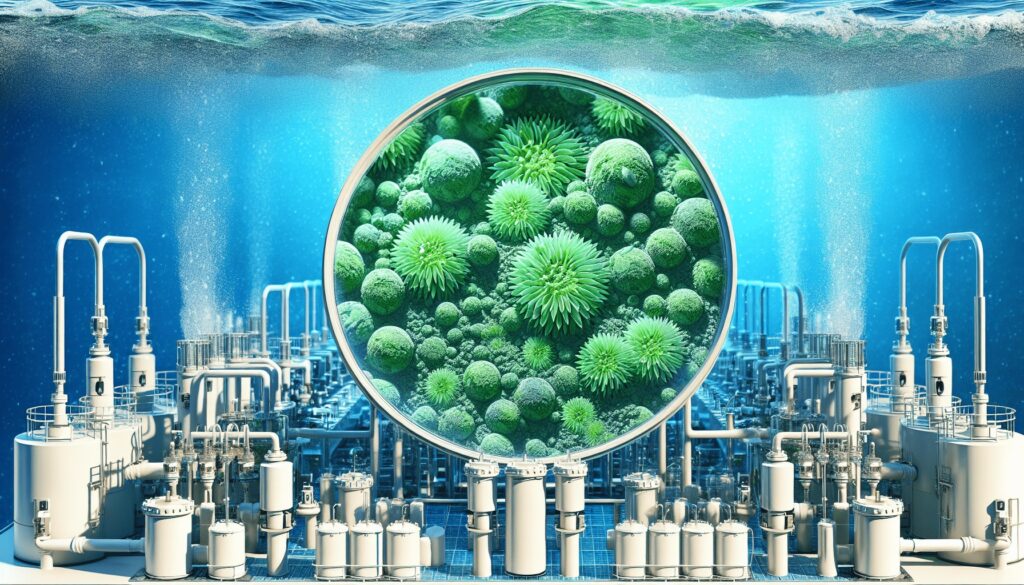Have you ever wondered how to effectively get rid of algae in an activated sludge plant? It’s a challenge that many in wastewater management face, but understanding the intricacies of this issue can help tackle it head-on. Managing algae growth is crucial for maintaining the efficiency and quality of wastewater treatment processes, but it often feels like a complex puzzle. Let’s figure this out together!

Understanding Algae in Activated Sludge Plants
What Are Algae?
Algae are simple photosynthetic organisms found in various water bodies, and they play a role in aquatic ecosystems. These organisms are diverse, ranging from microscopic phytoplankton to large seaweeds. In wastewater treatment plants, particularly in activated sludge systems, algae presence can have mixed effects.
Why Is Algae a Problem in Activated Sludge Systems?
While algae are not intrinsically harmful, their presence in activated sludge systems can pose operational challenges. They can clog systems, cause fluctuations in dissolved oxygen levels, and create aesthetic issues with the final effluent. Understanding why algae proliferate in these systems is the first step toward effective management.
Causes of Algal Bloom in Wastewater Treatment
Nutrient Availability
Activated sludge plants paradoxically provide an ideal habitat for algae. Abundant nutrients, especially nitrogen and phosphorus, can fuel rapid algal growth. These nutrients are essential for the algae’s lifecycle, encouraging blooms when present in excessive quantities.
Light Penetration
Light is another critical factor. Most activated sludge tanks are exposed to light, facilitating conditions for algae to thrive, especially during warmer months. The combination of ample light and nutrients creates the perfect storm for algae to flourish.
Temperature and Climate Conditions
Algae populations are sensitive to temperature changes. Warm temperatures accelerate their growth, so seasonal variations contribute to blooms. Understanding local climate conditions can help in predicting and managing algae issues.
Consequences of Algae Proliferation
Operational Challenges
Algae can interfere with the operation of treatment plants by clogging filters and membranes and causing sludge bulking. This thickens the sludge layer, impeding settlement and increasing operational costs.
Quality of Effluent
Excessive algae can worsen the quality of treated water by increasing turbidity, contributing to odor issues, and potentially causing regulatory compliance challenges.
Resource Consumption
Managing algae often requires significant resources, both in terms of manpower and chemicals. This increases the operating costs and environmental impact of treatment plants.
Strategies to Control Algae Growth
Nutrient Management
One of the best strategies to control algae is to manage nutrient levels. Reducing the input of nutrients such as nitrogen and phosphorus can significantly diminish algal growth. Utilize pre-treatment processes to remove nutrients before they reach the main treatment system.
Light Control
Minimizing light penetration into tanks can prevent algae from receiving the energy they need. Covering open tanks or using light-blocking materials can be effective solutions.
Temperature Regulation
Although controlling temperature may not always be feasible, being mindful of thermal inputs and using strategic shading can help. During hotter months, consider operational adjustments to mitigate thermal effects.
Promoting Biological Competition
Introduce or encourage other microorganisms that compete with algae for resources. By promoting a balanced microbial community, it’s possible to reduce the dominance of algae.

Technological Solutions for Algae Control
Using Algaecides
Algaecides can effectively manage small-scale algal blooms, although they must be used judiciously to avoid harming beneficial organisms. Always follow recommended dosages and regulations.
Oxidation Technologies
Technologies like ozone and UV treatment can disrupt algae growth. These oxidation methods break down cellular structures, effectively controlling algal populations without residual chemicals.
Membrane Filtration
Advanced filtration systems can physically remove algae from treated water, enhancing effluent quality. Membranes need regular maintenance but are effective for both large-scale and localized applications.
Ultrasound Technology
This emerging technology targets algae by using ultrasonic waves to break down their cellular walls. It’s a non-invasive and chemical-free method gaining popularity in modern wastewater management facilities.
Implementing Best Practices
Regular Monitoring
Frequent monitoring can help detect early signs of algal growth, allowing for proactive management. Use water tests to track nutrient levels, temperature changes, and algae presence regularly.
Adaptive Management Plans
Create dynamic management plans that can adjust to changing conditions. Regularly update these plans based on monitoring data and technological advancements.
Staff Training
Educate your team on the importance of controlling algae and the best practices for prevention and treatment. Proper training can improve response times and the effectiveness of implemented strategies.
Community Engagement
Engage with the community and relevant stakeholders to promote practices that prevent nutrient runoff into wastewater systems. Public awareness can contribute significantly to reducing nutrient loads.
Future Trends in Algae Management
Bioengineering Solutions
Advancements in bioengineering might soon provide novel ways to manipulate microbial communities to control algal growth effectively. These promising solutions offer a glimpse into future wastewater management tactics.
Smart Monitoring Systems
The integration of IoT and AI in monitoring systems can provide more accurate and real-time data, making it easier to manage algae proactively. These systems can optimize treatment processes and reduce human error.
Sustainable Practices
With a growing emphasis on sustainability, future practices will likely focus on eco-friendly solutions that minimize chemical usage. Encouraging natural algal predators and fostering ecological balance may become standard methods.
Legislative and Regulatory Changes
Expect to see more comprehensive regulations aimed at reducing nutrient pollution, with an emphasis on collaboration across different sectors to tackle algae issues at their source.
Eliminating algae in activated sludge plants requires a nuanced understanding of the factors that encourage its growth and the potential solutions. By implementing a combination of strategies tailored to specific conditions, it’s possible to manage algae effectively, ensuring operational efficiency and high-quality effluent. Through thoughtful practices and continued innovation, managing algae can be integrated seamlessly into the broader framework of wastewater treatment.